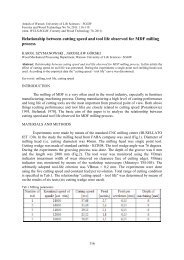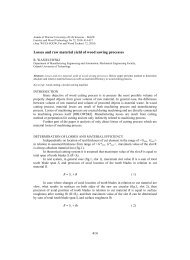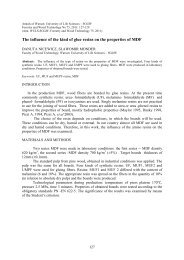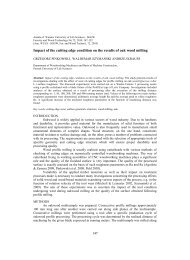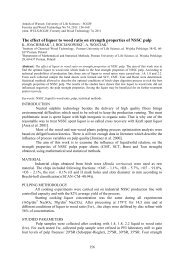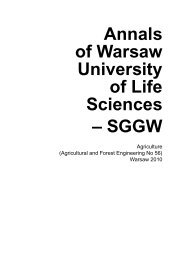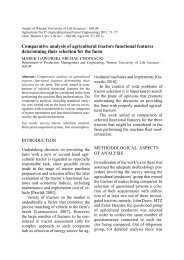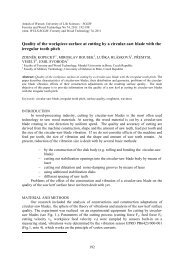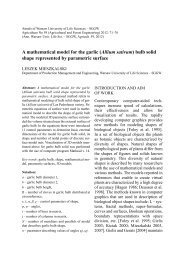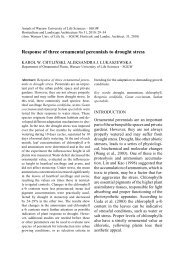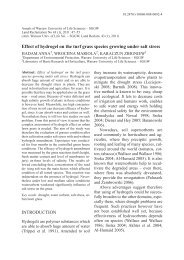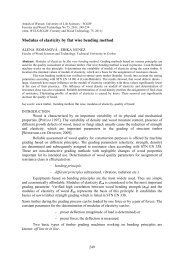Annals of Warsaw University of Life Sciences – SGGW. Animal ...
Annals of Warsaw University of Life Sciences – SGGW. Animal ...
Annals of Warsaw University of Life Sciences – SGGW. Animal ...
Create successful ePaper yourself
Turn your PDF publications into a flip-book with our unique Google optimized e-Paper software.
40 J. Gruszczyńska, M. Łukasiewicz<br />
(29 cocks and 24 hens) from the experimental<br />
flock <strong>of</strong> Ayam Cemani hens. The<br />
experiment was conducted at the Poultry<br />
Farm <strong>of</strong> the <strong>Warsaw</strong> <strong>University</strong> <strong>of</strong> Live<br />
<strong>Sciences</strong> in Obory. Genomic DNA was<br />
extracted from the blood by phenol-chlor<strong>of</strong>orm<br />
extraction. The presence and the<br />
purity <strong>of</strong> isolated DNA was checked on a<br />
NanoDropp spectrophotometer (Thermo<br />
Scientific).<br />
Five microsatellite sequences were<br />
used as a tool to determine genetic diversity<br />
<strong>of</strong> the bird population examined. Owing to<br />
the specific character <strong>of</strong> the experiment,<br />
in molecular analysis the microsatellite<br />
sequences were selected so as to be<br />
linked with the body weight <strong>of</strong> the hens.<br />
On the basis <strong>of</strong> literature, 5 microsatellite<br />
sequences were chosen as follows:<br />
MCW0145, MCW0184, MCW0210,<br />
LEI0071, and ADL0306 (Atzmon et al.,<br />
1998; Weissmann et al., 1998).<br />
PCR amplification<br />
Five pairs <strong>of</strong> primers <strong>of</strong> microsatellite<br />
sequences were selected from the Roslin<br />
Institute chicken mapping database<br />
ArkDB (http://www.thearkdb.org).<br />
Forward primers were labelled with Cy5<br />
marker. The reaction mixture comprised<br />
primers each at 20ppmol, dNTP MIX,<br />
1.0 unit <strong>of</strong> Taq polymerase (Sigma) per<br />
24 μl reaction mixture, 1 ng template<br />
genomic DNA (prepared from red blood<br />
cells) in each reaction mixture, and 5 μl<br />
<strong>of</strong> 10x reaction buffer (100 mM Tris<br />
HCl, 15mM MgCl2, 50mM KCl, 0.01%<br />
gelatin). The cycling temperature was as<br />
follows: denaturation was run at 95 o C<br />
for 30 s; annealing was run for 60 s at<br />
46 o C for LEI0071, 47 o C for ADL0306,<br />
51 o C for MCW0210 and MCW0145,<br />
and 56 o C for MCW0184, depending on<br />
primer composition; extension war run<br />
at 72 o C for 60s.The reaction was carried<br />
out for 30 cycles. The final extension<br />
was run at 72 o C for 10 min. The conditions<br />
<strong>of</strong> polymerase chain reaction (PCR)<br />
were employed as earlier established by<br />
Gruszczyńska and Michalska (2005) and<br />
by Gruszczyńska et al. (2007).<br />
The birds were genotyped, using an<br />
automatic sequencer ALF Express (Pharmacia<br />
LKB).<br />
Statistical analysis<br />
Results <strong>of</strong> the molecular analysis were<br />
used to estimate the frequency <strong>of</strong> alleles <strong>of</strong><br />
the analyzed loci, frequency <strong>of</strong> genotypes<br />
(homo- and heterozygotes), expected<br />
heterozygosity H E (Ott, 1992), and to<br />
determine the Polymorphic Information<br />
Content PIC (Botstein et al., 1980). The<br />
frequency <strong>of</strong> alleles, H O (observed heterozygosity),<br />
H E (expected heterozygosity)<br />
and PIC (polymorphic information<br />
content) were computed using Cervus<br />
3.0.3. s<strong>of</strong>tware (Kalinowski et al., 2007),<br />
whereas the frequency <strong>of</strong> genotypes <strong>–</strong> with<br />
the use <strong>of</strong> an original ALFREQ s<strong>of</strong>tware<br />
(Tereba Z., Tereba A., 2005).<br />
RESULTS AND DISCUSSION<br />
In the analyzed population <strong>of</strong> Ayam<br />
Cemani breed hens the polymorphism<br />
within all <strong>of</strong> 5 selected microsatellite<br />
sequences. The lengths <strong>of</strong> the sequences<br />
were: 156<strong>–</strong>168bp for MCW0210; 240 and<br />
260bp for MCW0184; 280<strong>–</strong>300bp for<br />
LEI0071; 206<strong>–</strong>218bp for MCW0145, and<br />
119<strong>–</strong>125bp for ADL0306 (Tab. 1). The<br />
number <strong>of</strong> alleles was ranging from 2 for<br />
MCW0184 sequence to 4 for MCW0145<br />
sequence. Within particular microsatellite<br />
loci we observed the following



